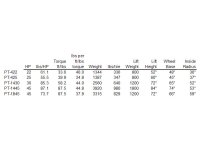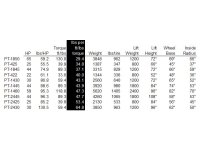marrt
Platinum Member
I have attached a small spreadsheet I created to compare the different PT models. Specifically, I wanted to compare HP and Torque ratings for each tractor, by the weight of the tractor. I was trying to get an understanding of how powerful a given tractor would be for its weight. For example, a tractor with the lowest weight per ft/lb of torque should, hypothetically, perform better in a give activity such as mowing on hills. Using this theory (which may be flawed…see below), the 425 would be the most powerful tractor, relatively speaking. The 1845 would be next.
That said, there are several problems with this approach, such as:
- torque ratings for Duetz are converted from nm to ft/lbs. Not sure the measurement methodology is the same.
- I assumed PT still uses the L 1011 Deutz engine family and not the L 2011
- torque ratings are not measured at the maximum HP output but at maximum torque. Therefore, real world behavior may be different.
- the torque rating for wheel motors was not considered
- the diameter of the tires was not considered
- the weight of the mower and the amount of power needed to drive the mower motor was not considered
- etc…..
That said, there are several problems with this approach, such as:
- torque ratings for Duetz are converted from nm to ft/lbs. Not sure the measurement methodology is the same.
- I assumed PT still uses the L 1011 Deutz engine family and not the L 2011
- torque ratings are not measured at the maximum HP output but at maximum torque. Therefore, real world behavior may be different.
- the torque rating for wheel motors was not considered
- the diameter of the tires was not considered
- the weight of the mower and the amount of power needed to drive the mower motor was not considered
- etc…..

